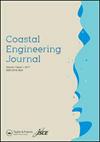Questioning the hazard map-based rebuilding process: learning from the 2018 Sulawesi earthquake in Indonesia
IF 1.9
3区 工程技术
Q3 ENGINEERING, CIVIL
引用次数: 1
Abstract
ABSTRACT To reduce hazards in post-disaster rebuilding, governments often first revise existing hazard maps to update land use plans and regulations. This sequence assumes that the disaster event immediately improves knowledge of the hazard. To learn from an actual case, we document PASIGALA’s rebuilding process following the 2018 Central Sulawesi earthquake. We reviewed public documents in-depth, assessed coastal hazards with new information, and reflected on our field observations. We documented the 3.5-year situation in detail and developed recovery narratives. We also found that the actual post-disaster development does not fully incorporate the planned goals of hazard risk reduction. Reasons include: i) the need to create a hazard map before knowing the hazard’s mechanism; ii) the scale of hazard mapping does not correspond to that of individual building parcels; iii) residents, out of necessity, restart their lives in the prohibited areas, and iv) relocation plans do not attract affected residents when rebuilding their lives. Governments may create simplified hazard maps to facilitate timely rebuilding, but this overlooks nuanced problems residents face, further complicating their situation. Although the hazard maps show the region’s potential hazards, the next disaster could be different. We conclude the current practice of hazard map-based rebuilding needs more deliberation.质疑基于危险地图的重建过程:从2018年印度尼西亚苏拉威西地震中学习
摘要为了减少灾后重建中的危害,政府通常首先修订现有的危害地图,以更新土地利用规划和法规。该序列假定灾难事件会立即提高对危险的认识。为了从实际案例中学习,我们记录了PASIGALA在2018年中苏拉威西地震后的重建过程。我们深入审查了公开文件,用新的信息评估了沿海灾害,并反思了我们的实地观察。我们详细记录了3.5年的情况,并制定了恢复说明。我们还发现,实际的灾后发展并没有完全纳入减少灾害风险的计划目标。原因包括:i)在了解危险机制之前,需要创建危险地图;ii)危险地图的比例尺与单个建筑地块的比例尺不一致;iii)居民出于必要,在禁区内重新开始他们的生活,以及iv)搬迁计划在重建他们的生活时没有吸引受影响的居民。政府可能会创建简化的危险地图,以便于及时重建,但这忽略了居民面临的细微问题,使他们的处境更加复杂。尽管危险地图显示了该地区的潜在危险,但下一次灾难可能会有所不同。我们得出结论,当前基于危险地图的重建实践需要更多的考虑。
本文章由计算机程序翻译,如有差异,请以英文原文为准。
求助全文
约1分钟内获得全文
求助全文
来源期刊

Coastal Engineering Journal
工程技术-工程:大洋
CiteScore
4.60
自引率
8.30%
发文量
0
审稿时长
7.5 months
期刊介绍:
Coastal Engineering Journal is a peer-reviewed medium for the publication of research achievements and engineering practices in the fields of coastal, harbor and offshore engineering. The CEJ editors welcome original papers and comprehensive reviews on waves and currents, sediment motion and morphodynamics, as well as on structures and facilities. Reports on conceptual developments and predictive methods of environmental processes are also published. Topics also include hard and soft technologies related to coastal zone development, shore protection, and prevention or mitigation of coastal disasters. The journal is intended to cover not only fundamental studies on analytical models, numerical computation and laboratory experiments, but also results of field measurements and case studies of real projects.
 求助内容:
求助内容: 应助结果提醒方式:
应助结果提醒方式:


